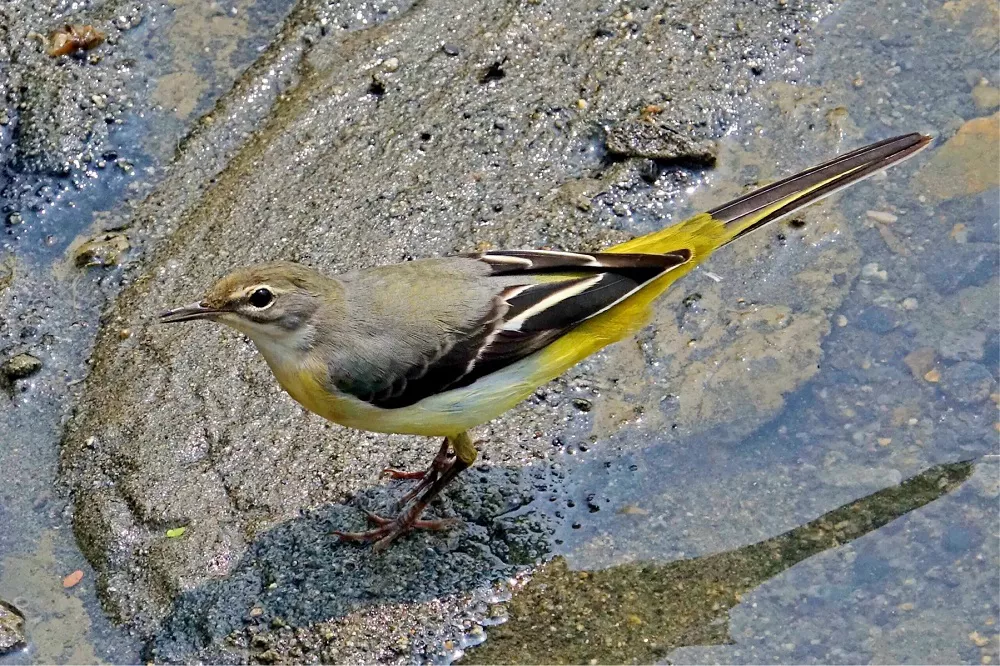Wagtails are a group of small, slender birds belonging to the family Motacillidae. These birds are characterized by their long tails that wag up and down when they walk or run on the ground. Among the wagtails, two species stand out as being particularly similar in appearance: the Grey Wagtail (Motacilla cinerea) and the Yellow Wagtail (Motacilla flava). In this article, we will explore the key differences between these two species.
Physical Appearance
One of the most notable differences between Grey Wagtails and Yellow Wagtails is their physical appearance. Grey Wagtails have a grayish-blue back, with a bright yellow vent and undertail. They have a black throat and face, and a white eyebrow stripe. Their wings are dark with white edges, and their tail is long and dark with white outer feathers.
On the other hand, Yellow Wagtails have a more vibrant appearance. They have a bright yellow-green back and head, with a yellow underside. They have a distinctive yellow eyebrow and dark eye-stripe. Their wings are brown with yellow edges, and their tail is long with dark outer feathers.
Habitat
Grey Wagtails and Yellow Wagtails can both be found throughout Europe and Asia, but they differ in their preferred habitats. Grey Wagtails are usually found near running water, such as streams and rivers, where they hunt for insects and larvae. They have also been known to inhabit urban areas, such as parks and gardens, where they feed on insects attracted to streetlights at night.
In contrast, Yellow Wagtails are typically found in open grasslands and meadows, where they feed on insects and seeds. They migrate to Africa during the winter months, and during this time, they can be found in wetlands, rice fields, and other agricultural areas.
Behaviour
When it comes to their behaviour, Grey Wagtails and Yellow Wagtails also have distinct differences. Grey Wagtails are known for their distinctive flight, which is characterized by a series of undulating dips and rises. They tend to be more secretive than Yellow Wagtails, often hiding in dense vegetation near waterways.
Yellow Wagtails are more gregarious and can often be found in flocks during migration. They are also known for their distinctive “tail-wagging” behaviour, which is used to signal alarm or excitement.
Vocalizations
Another key difference between Grey Wagtails and Yellow Wagtails is their vocalizations. Grey Wagtails have a sweet, high-pitched song that is characterized by a series of trills and warbles. Their calls are sharp and metallic, often described as “tseew tseew”.
Yellow Wagtails, on the other hand, have a more varied and complex song. Their calls are softer and more melodic, often described as “tswee-tswee-tsweep”. They also make a distinctive “chiswick” call during flight.
Breeding
Grey wagtails breed in the spring and summer, usually building their nests near fast-flowing streams or rivers. The female lays between four and six eggs, which she incubates for around two weeks. After hatching, the chicks are fed by both parents and fledge after around three weeks.
Yellow wagtails also breed in the spring and summer, often building their nests on the ground or in low vegetation. The female lays between four and seven eggs, which she incubates for around two weeks. After hatching, the chicks are fed by both parents and fledge after around two weeks.
Conservation Status
Both Grey Wagtails and Yellow Wagtails are considered to have populations that are stable, although both species face threats from habitat loss and degradation. Grey Wagtails are particularly vulnerable to pollution and changes in river management practices, which can impact the availability of suitable breeding and foraging habitats. Yellow Wagtails, on the other hand, are threatened by agricultural intensification and the conversion of grasslands into croplands.
Conclusion
In conclusion, Grey Wagtails and Yellow Wagtails are two closely related species that share many similarities in appearance and behaviour. However, they differ in their physical appearance, preferred habitats, behaviour, vocalizations, and conservation status. Understanding these differences can help birdwatchers and enthusiasts identify these birds in the field and appreciate their unique characteristics. Despite the challenges they face, these birds continue to thrive in their natural habitats, providing a valuable reminder of the beauty and diversity of the natural world.
Related topics:
- What is Gray wagtail?
- How long do Gray wagtails live for?
- What is the Yellow Wagtail?
- Where do Yellow wagtails nest?


 Facebook
Facebook  Instagram
Instagram  Youtube
Youtube 